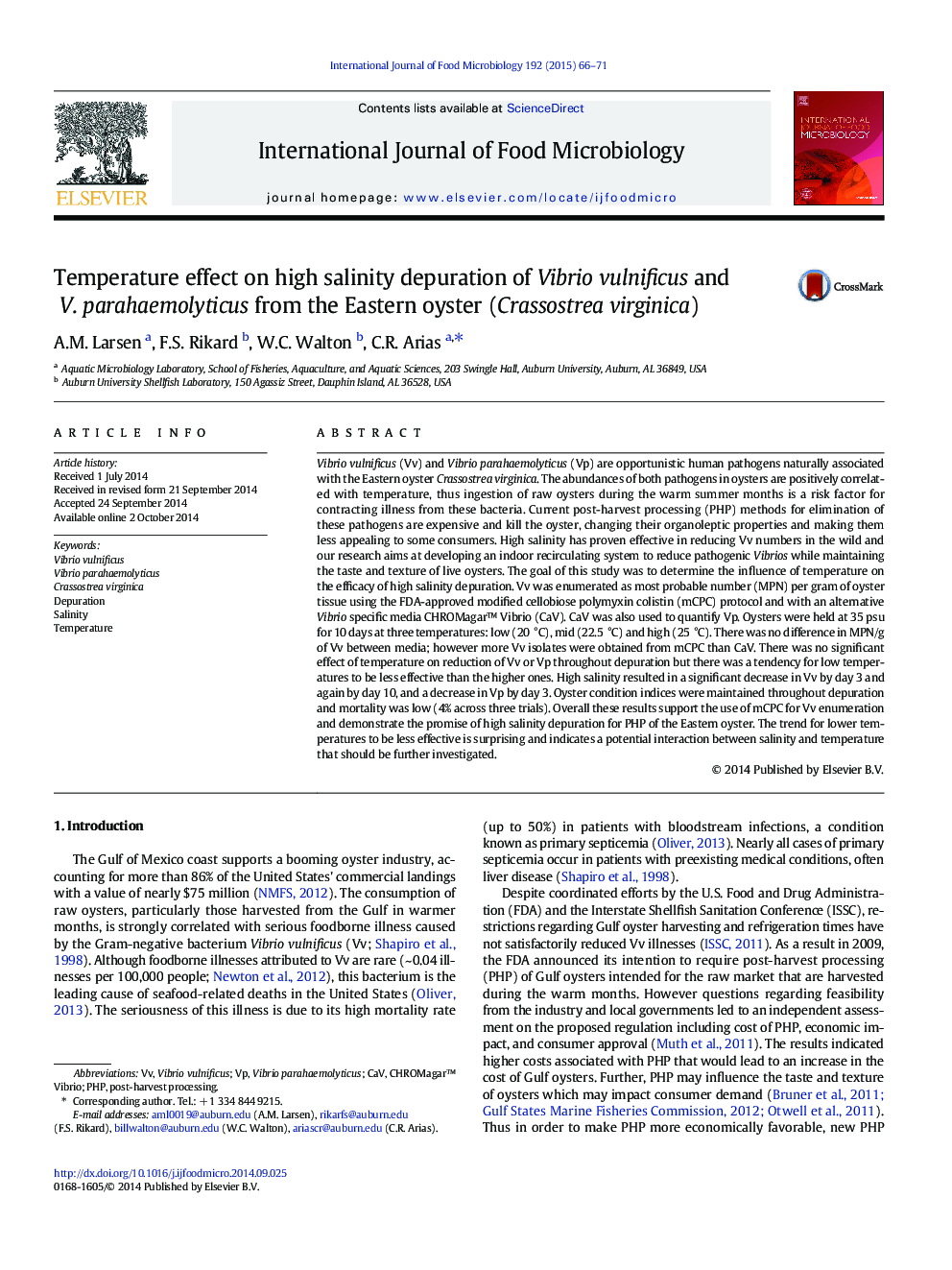| کد مقاله | کد نشریه | سال انتشار | مقاله انگلیسی | نسخه تمام متن |
|---|---|---|---|---|
| 6289964 | 1616591 | 2015 | 6 صفحه PDF | دانلود رایگان |
عنوان انگلیسی مقاله ISI
Temperature effect on high salinity depuration of Vibrio vulnificus and V. parahaemolyticus from the Eastern oyster (Crassostrea virginica)
دانلود مقاله + سفارش ترجمه
دانلود مقاله ISI انگلیسی
رایگان برای ایرانیان
کلمات کلیدی
موضوعات مرتبط
علوم زیستی و بیوفناوری
علوم کشاورزی و بیولوژیک
دانش تغذیه
پیش نمایش صفحه اول مقاله

چکیده انگلیسی
Vibrio vulnificus (Vv) and Vibrio parahaemolyticus (Vp) are opportunistic human pathogens naturally associated with the Eastern oyster Crassostrea virginica. The abundances of both pathogens in oysters are positively correlated with temperature, thus ingestion of raw oysters during the warm summer months is a risk factor for contracting illness from these bacteria. Current post-harvest processing (PHP) methods for elimination of these pathogens are expensive and kill the oyster, changing their organoleptic properties and making them less appealing to some consumers. High salinity has proven effective in reducing Vv numbers in the wild and our research aims at developing an indoor recirculating system to reduce pathogenic Vibrios while maintaining the taste and texture of live oysters. The goal of this study was to determine the influence of temperature on the efficacy of high salinity depuration. Vv was enumerated as most probable number (MPN) per gram of oyster tissue using the FDA-approved modified cellobiose polymyxin colistin (mCPC) protocol and with an alternative Vibrio specific media CHROMagar⢠Vibrio (CaV). CaV was also used to quantify Vp. Oysters were held at 35 psu for 10 days at three temperatures: low (20 °C), mid (22.5 °C) and high (25 °C). There was no difference in MPN/g of Vv between media; however more Vv isolates were obtained from mCPC than CaV. There was no significant effect of temperature on reduction of Vv or Vp throughout depuration but there was a tendency for low temperatures to be less effective than the higher ones. High salinity resulted in a significant decrease in Vv by day 3 and again by day 10, and a decrease in Vp by day 3. Oyster condition indices were maintained throughout depuration and mortality was low (4% across three trials). Overall these results support the use of mCPC for Vv enumeration and demonstrate the promise of high salinity depuration for PHP of the Eastern oyster. The trend for lower temperatures to be less effective is surprising and indicates a potential interaction between salinity and temperature that should be further investigated.
ناشر
Database: Elsevier - ScienceDirect (ساینس دایرکت)
Journal: International Journal of Food Microbiology - Volume 192, 2 January 2015, Pages 66-71
Journal: International Journal of Food Microbiology - Volume 192, 2 January 2015, Pages 66-71
نویسندگان
A.M. Larsen, F.S. Rikard, W.C. Walton, C.R. Arias,